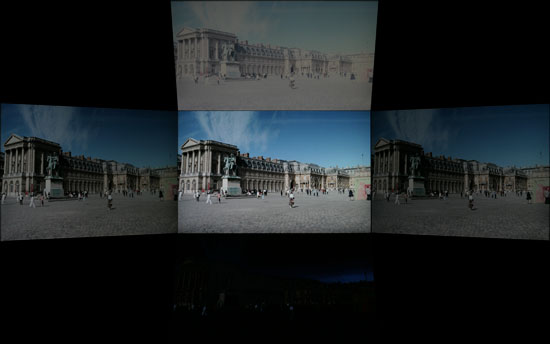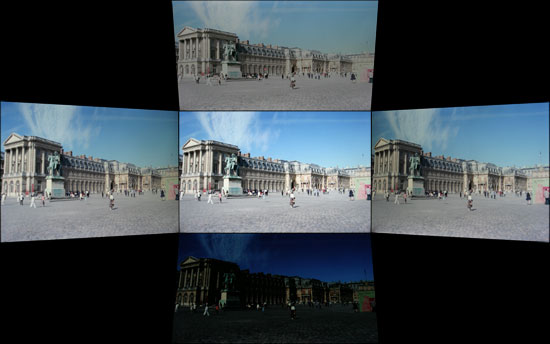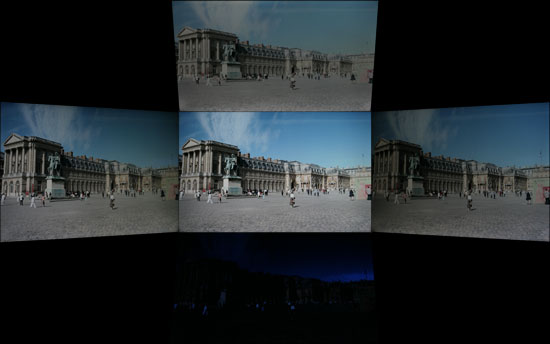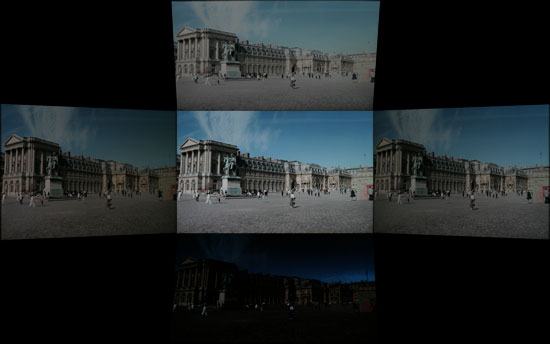Laptop LCD Roundup: Road Warriors Deserve Better
by Jarred Walton on May 22, 2007 5:00 AM EST- Posted in
- Displays
Viewing Angles
Viewing angles are one of those specifications that have become very inflated by the manufacturers. The basic requirement is that a display has to maintain a 10:1 contrast ratio in order to qualify as "viewable". The reality is that most LCDs are unfit for viewing outside of about a 45° arc, and on laptops you may not even get that much of a viewing arc. While we doubt that most people would want to view a display from an oblique angle, the typical positioning of a laptop - sitting on your lap only a couple feet from your eyes - can make viewing angles more important. Unfortunately, as all of the LCDs appear to use TN panels, that means viewing angles become more important and the technology becomes less satisfactory.
We used a Canon Digital Rebel SLR camera to take shots from head-on as well as from the left, right, top, and bottom at ~30° angles. We then combined the images into a single representative shot, showing how brightness and contrast ratios are affected in off-angle viewing. The camera was set to manual mode and an ISO value of 400 with an exposure time of 1/60s. While there's no substitute for actually sitting in front of a display yourself and using it, we did our best to use settings that generated images similar to what we saw in person. With all of the laptops photographed under the same conditions and with the same settings, the relative appearance of the images is at least as important as how each image looks individually.
Again, the ASUS G2P clearly comes out on top and offers the best overall viewing angles. The Dell XPS M1710 and MSI S271 are somewhat similar, though we would give the edge to the Dell laptop. The ASUS A8Js on the other hand ranks at the bottom, particularly in the areas of vertical viewing angles. On desktop systems, horizontal viewing angles are often more important, but in everyday use we find that vertical viewing angles are definitely a problem with many laptops. A slight tilt of your lap or a straightening of your back, and the perceived image can quickly become washed out.
Viewing angles are one of those specifications that have become very inflated by the manufacturers. The basic requirement is that a display has to maintain a 10:1 contrast ratio in order to qualify as "viewable". The reality is that most LCDs are unfit for viewing outside of about a 45° arc, and on laptops you may not even get that much of a viewing arc. While we doubt that most people would want to view a display from an oblique angle, the typical positioning of a laptop - sitting on your lap only a couple feet from your eyes - can make viewing angles more important. Unfortunately, as all of the LCDs appear to use TN panels, that means viewing angles become more important and the technology becomes less satisfactory.
We used a Canon Digital Rebel SLR camera to take shots from head-on as well as from the left, right, top, and bottom at ~30° angles. We then combined the images into a single representative shot, showing how brightness and contrast ratios are affected in off-angle viewing. The camera was set to manual mode and an ISO value of 400 with an exposure time of 1/60s. While there's no substitute for actually sitting in front of a display yourself and using it, we did our best to use settings that generated images similar to what we saw in person. With all of the laptops photographed under the same conditions and with the same settings, the relative appearance of the images is at least as important as how each image looks individually.
 ASUS A8Js  ASUS G2P  Dell XPS M1710  MSI S271 |
| Click to enlarge |
Again, the ASUS G2P clearly comes out on top and offers the best overall viewing angles. The Dell XPS M1710 and MSI S271 are somewhat similar, though we would give the edge to the Dell laptop. The ASUS A8Js on the other hand ranks at the bottom, particularly in the areas of vertical viewing angles. On desktop systems, horizontal viewing angles are often more important, but in everyday use we find that vertical viewing angles are definitely a problem with many laptops. A slight tilt of your lap or a straightening of your back, and the perceived image can quickly become washed out.










55 Comments
View All Comments
Axbattler - Tuesday, May 22, 2007 - link
I am also very interested in this. I know that the Sony screen tend to be a love or hate affair: on one hand they are bright and and clear, but many can't get past the reflection. I'd like to know if there are any monitors that's similar to Sony's minus the refection.figuerc - Tuesday, May 22, 2007 - link
My Thinkpad X60 tablet still comes with an IPS screen and it is the best screen I have ever used period.Pirks - Tuesday, May 22, 2007 - link
yeah, this article is a waste of time considering they have omitted IPS screen notebooks. I saw the title, thought "yess!!" and went to read it, you know I always wanted to see good comparison between IPS and TN notebook displays... and in the first page they write "uh we don't know about any notebook with IPS panel" - WTF?! alright Anand and Co, it was agood job, you barely made it but to make TRYLY high-quality article you really have to include at least one IPS thinkpad. I'll keep waiting for your _proper_ notebook screen comparison article, it's likely you do it firstafter all I haven't seen decent notebook TN panel reviews online before yours, so once you add an IPS notebook - job's done!
DigitalFreak - Tuesday, May 22, 2007 - link
Again Pirks, STFU.Pirks - Tuesday, May 22, 2007 - link
sorry for typos, I pressed post button too quick, should be truly not trylyJarredWalton - Tuesday, May 22, 2007 - link
This is a starting point Pirks, not an end point. I tried to make that clear. All notebooks that we review in the future will include a more in-depth review of the display. As for getting the Lenovo Thinkpad X60 (or something similar if there are other IPS laptops), we're working on it. Unfortunately, previous attempts to contact Lenovo for a review unit have been unsuccessful, so we review what we have.Pirks - Wednesday, May 23, 2007 - link
okay, okay, if this is just the beginning - I'm going to STFU, if only to make DigitalFreak quietwaiting for your IPS notebook reviews, and thanks for making this just the beginning - I really like the idea of the article, and IPS panels is the only things that's missing
I wasn't criticizing the article per se, I only disliked the omission of the IPS panels. sorry for not stating it clearly
JarredWalton - Wednesday, May 23, 2007 - link
I knew what you meant, and I was glad to find out that I was wrong and that there were some non-TN panels available in laptops. I'll be curious to see if the IPS models (assuming I can get some sent my way) perform noticeably better. After all, the best of the laptops I've looked at so far still trails behind desktop TN models, most likely due to backlighting and power concerns. It could be that the IPS laptops follow that trend.Pirks - Wednesday, May 23, 2007 - link
hey Jarred, here's another mistake you made in the article: "LED backlighting is one technology that holds a lot of promise, and it has only just begun to show up on desktop LCDs" - now don't you know that Sony has been selling notebooks with LED backlighting for some time already? why have you said that it only appeared on desktop LCD while in fact Sony was making notebooks with LEDs waaay before desktop LCDs with LED appeared?Pirks - Wednesday, May 23, 2007 - link
exactly! this is why I'm waiting for your IPS panel notebooks article veeery impatiently! bring it on! :)